 Category: Blog
Category: Blog
Tick Prevention For Ontario Residents

Learn what you can do today to protect your pets against tick-borne diseases
Did you know that Toronto is considered a high risk area for Lyme disease?
In Ontario, ticks have been implicated in the transmission of nearly a dozen human and animal infectious diseases, including lyme disease, ehrlichiosis, anaplasmosis and babesiosis. Ticks will attach onto your pet (or you) and bury their head in their host to feed on blood. They are active during any temperature above 0℃, meaning your pet is at risk of tick bites and infections almost year-round.
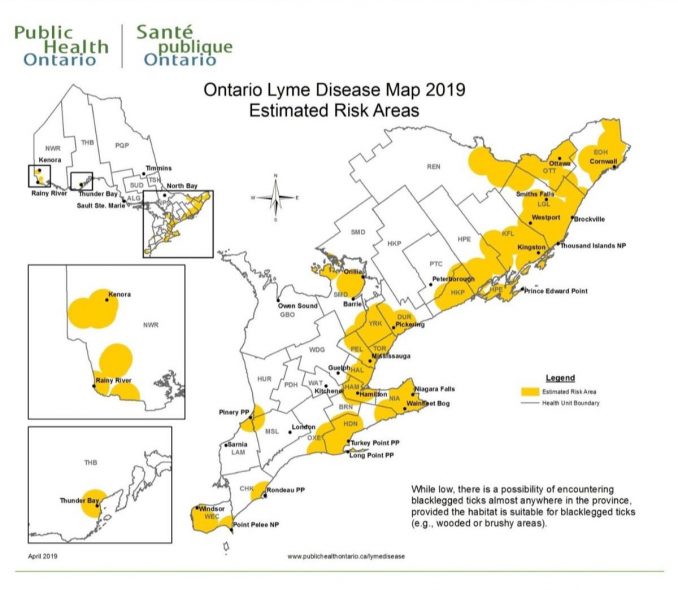
Tick activity is temperature-driven, not seasonal.
At Centre Street Animal Hospital, we normally recommend tick-preventative medication for 9 months of the year as ticks can be active as early as February and as late as December (adult ticks are most active in the spring and fall, and nymphs (younger ticks) prefer the warmer months of July/August).With the milder winters we’ve been experiencing, we are monitoring the tick activity closely each year, and year-round tick protection may become recommended in the near future.
The bottom line is – if it’s above freezing, both you and your pet should be protected from ticks, no matter what month of the year! This is why it is important to speak to your Veterinarian or veterinary technician about simple-to-use tick medications for your pet. There are now several choices available, and depending on their environment and risk, we can recommend the correct product for your pet’s individual needs. Determining the diseases present in your area, annual testing for these diseases, and taking extra precaution outdoors are also recommended.
How to check for ticks on your pets:
When the benefits greatly outweigh the risks.
As with any medication, there is a small chance of side-effects. All products in the isoxazoline class (tick & flea) have potential for neurological side-effects in dogs and cats. We are aware and attentive to the media surrounding this class of medications, however, it is important to also consider other contributing factors such as prior medical conditions, underlying disease, other medications used at the same time, and severe overdose.
The FDA considers products in the isoxazoline class to be safe and effective for dogs and cats, and issued its safety communication so that pet owners and veterinarians can take it into consideration when choosing flea and tick products for their pets. We are 100% confident that the benefits of these medications vastly outweigh the very low risk of an adverse reaction. The well-being of our patients is incredibly important to us and we take great care in completing a proper examination and assessment to determine the most suitable course of treatment for your pets.

As a pet owner, you play an equal part in your pet’s healthcare, and we are here to educate and support you in every decision. Call us today to speak to our veterinary team about your pet’s current tick preventative regimen, or to arrange a visit to pick some up today. As always, we are here to help and answer any questions you may have.
Immunization Awareness!
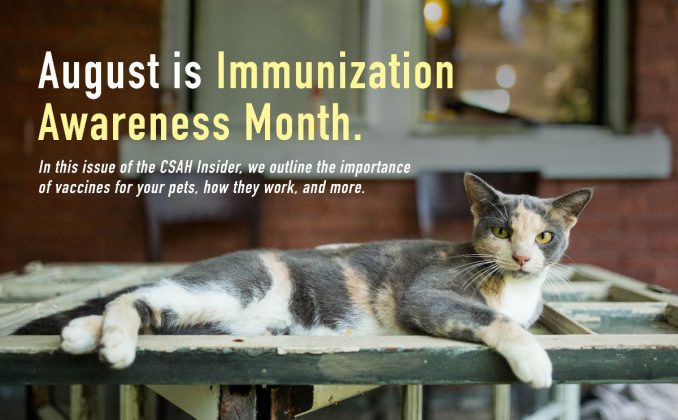
What is a vaccine, and how does it work in the body?
A vaccine is a preparation that helps the body’s immune system get ready to fight disease-causing organisms. If the immune system has “seen” an unfamiliar microbe (bacteria or virus) as part of a vaccine, it’s primed to produce antibodies if it “sees” (i.e. is exposed to) the same microbe again. Antibodies are what help the body fight infection and protect it from getting the same illness again. Vaccinations are intended to reduce the severity of the disease, or prevent the disease entirely, by creating immunity. Although they are not 100% guaranteed prevention, they are your pet’s best bet for protection.
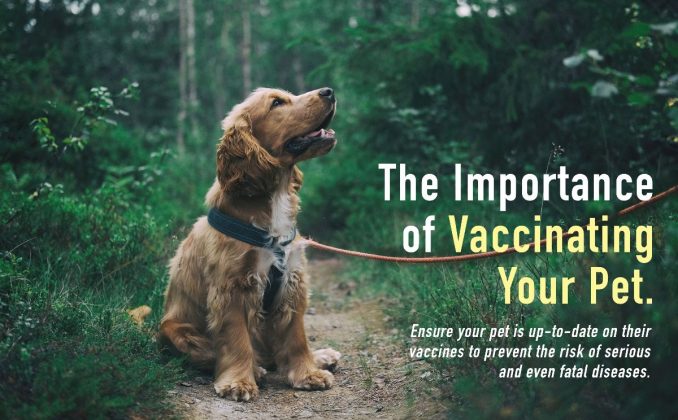
Are they safe for my pet?
The general answer is yes. As with any medical procedure, there is a small chance of side effects; in most cases, these risks are much smaller than the risks of the disease itself. Common side effects can include soreness at the injection site, sluggishness, and eating or drinking less for 12-24 hours; but most pets experience no ill effects at all. Very rare side effects can include allergic or autoimmune reactions, but know that the risks are below 1%. Vaccines can provide potentially life-saving benefits, and are one of the easiest ways to help pets live a long and healthy life. If you have any concerns please don’t hesitate to reach out to us.
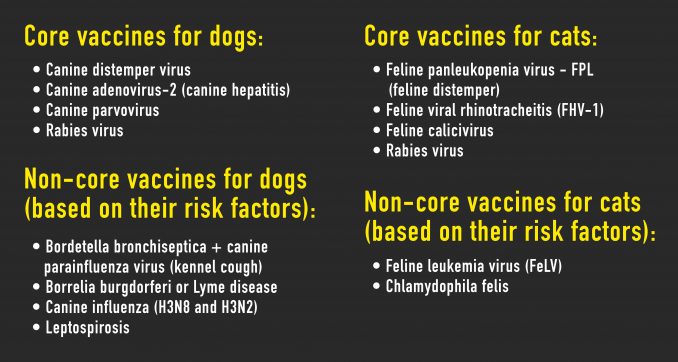
The most effective tool is prevention.
Vaccinations help protect pets from the risk of potentially serious and even fatal diseases. They not only cost considerably less than treatment, they are also far less stressful for pets and pet parents alike. Keeping your pet’s vaccines up to date is crucial for your pet’s well-being.
Vaccines are available to protect your pet against a wide variety of diseases. Although they are not yet able to eliminate or cure these diseases, vaccines for rabies, distemper, parvovirus, feline leukemia and panleukopenia have greatly reduced the incidences of disease – improving pet health and welfare, and preventing fatal outcomes.
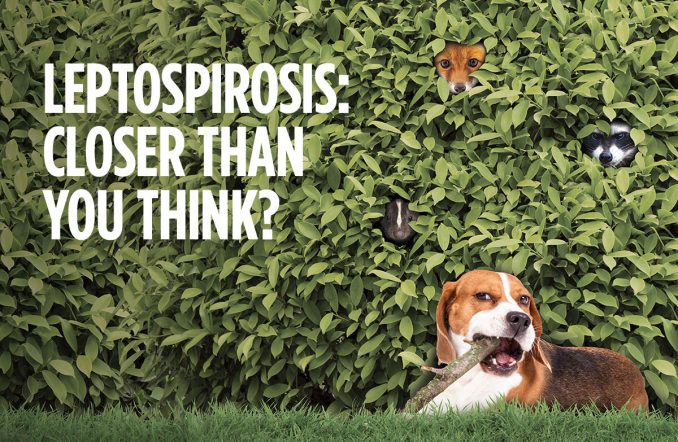
Although it is considered non-core, our hospital has seen an increase in Leptospirosis cases over the past few years. We are encouraging pet owners to take new consideration into this vaccine if it is not part of their pet’s current vaccine protocol.
Leptospirosis is caused by a bacteria that is found in soil and water, and can cause severe liver and kidney damage in the affected pet. In the Thornhill area, it is commonly passed through the urine of other mammals (raccoons, skunks, rodents), so it is very easy to contract in your local dog park or even your backyard. Unfortunately, Leptospirosis is often a difficult disease to diagnose as symptoms can be vague and can look like many other conditions before the disease progresses. Common early symptoms include vomiting, lethargy, depression, increased thirst, and fever. Leptospirosis is also a zoonotic disease, meaning it can be spread from animals to humans, so vaccination is one vital step needed to protect your pets and your family. Currently available vaccines will protect dogs for 12 months, so annual boosters are needed.
As a pet owner, you play an equal part in your pet’s healthcare, and we are here to educate and support you in every decision. Call us today to speak to our veterinary team about what specific vaccines your pet may need for their age and lifestyle. We are always here to help, and answer any questions you may have.
Welcoming Dr. Goldman to the CSAH Family!
We have some very exciting news!

We are pleased to welcome our newest Veterinarian to Centre Street Animal Hospital, Dr. Kineret Aloni-Goldman BSc, DVM. She comes to us from Milliken-Bridlewood Animal Clinic, but is no stranger to Centre Street Animal Hospital. Dr. Goldman has been an interim veterinarian in our clinic for over 10 years, and now she is officially joining us as a part-time doctor! If you would like to say hello, drop in anytime on Mondays or Wednesdays and join us in welcoming her to the CSAH Family!
Bio: Ever since she can remember, Dr. Goldman wanted to be a veterinarian. While growing up in Israel, she was actively involved in rehabilitating stray dogs and helping them find their forever homes. She earned her veterinary degree from the Ontario Veterinary College in Guelph in 2009, and her Bachelor of Science in Biology from York University. She also volunteered with a spay and neuter clinic in Thailand while in vet school. Before joining Centre Street Animal Hospital as a part-time veterinarian in June 2019, Dr. Goldman worked at several hospitals in the Greater Toronto Area. Her professional interests include surgery, internal medicine, preventative medicine and geriatrics. When not in the clinic, she works as a part-time shelter veterinarian and a surgeon for Toronto Animal Services. Outside of work, Dr. Goldman enjoys spending time in North York where she lives with her husband, three kids, and their rescue dog named Roy.
Grain-Free Diets: The Emerging Truth

The issue around grain-free pet foods has been growing this year, with scientists studying the effects of certain diets that may be linked to fatal canine heart disease. While this information is still under review, we thought it was important to share the data so you can be aware and make informed decisions about your pet’s diet and overall health.
The FDA has been collecting data on the potential connection between certain diets linked to 515 cases of the disease. Canine Dilated Cardiomyopathy, a disease of a dog’s heart muscle, can often result in congestive heart failure. We typically see larger breeds such as Dobermans and Great Danes affected by DCM, however many cases are now showing in smaller breeds, which suggests a lack of a genetic connection.
The agency defines “grain-free” as not containing corn, soy, wheat, rice, barley or other grains. Of the dog-food brands on the FDA’s list, 91% of the products investigated were labelled grain-free.

In its latest report, the FDA said it does not yet know how certain diets may be associated with DCM in dogs. The agency is encouraging pet owners to work directly with veterinarians or board-certified veterinary nutritionists to choose an appropriate diet for their pets. Pet owners should continue to report cases of dogs and cats with DCM that could be linked to diet. To report, use the online Safety Reporting Portal.
To summarize, this serves to illustrate the importance of feeding properly researched and well-balanced diets. Looking for the AAFCO statement, and ensuring the food has undergone feeding trials, can help in making educated decisions. Unfortunately, there are still no regulations in Canada within the pet food industry, meaning new companies can pop up all the time, so it is crucial that you be the advocate for your pet.
If you are feeding one of these brands to your pet, simply check to see if it is a “grain-free” version, and if so, look for another option. If you have any further questions or concerns, we are simply a phone call away. Feel free to contact us at 905-771-9855 to speak with one of our staff members, we are always here for you and your pet.
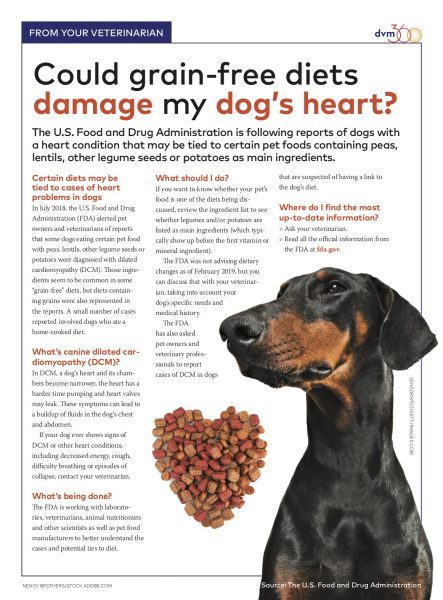
Click to hear our veterinarian’s top tips on choosing the right food for your pet.
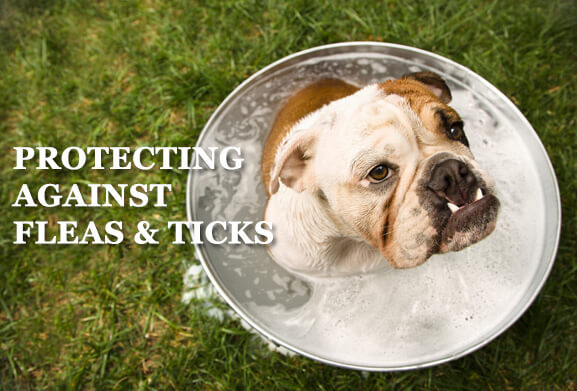
Fleas and Ticks
Are You Taking the Right Steps to Protect Your Pet from Fleas & Ticks?
With the beautiful spring weather upon us, many pets are spending more time outdoors. This is wonderful for pets, as well as their owners, but it also exposes your dog or cat to common pests like fleas and ticks.
In order to keep your furry friend healthy and happy, you must maintain a clean and safe environment and pay close attention to any abnormal signs. It is also important to bring your pet for regular annual or semi-annual checkups. Fleas and ticks might seem like a mere nuisance and not cause for concern, but they can pose serious health risks for your pets.
Medical Conditions Related to Fleas and Ticks
Fleas and ticks can cause life-threatening illnesses such as:
- Anemia
- Tapeworm
- Lyme Disease
- Erlichiosis
It is important to understand each of these conditions, including how to identify symptoms, the causes, the risks and the appropriate interventions.
Anemia
Anemia is a deficiency of red blood cells in dogs or cats. It is often caused by fleas, ticks, and hookworms, to which your pet can become exposed as they spend more time outdoors in the spring and summer months.
If you notice that your pet is unusually lethargic, it may be a sign of Anemia. Symptoms to look for include:
- Pale Gums
- Weakness or Lethargy
- Vomiting
- Abdominal Pain
- Blood in Urine
Tapeworm
Tapeworms grow in your pet’s intestines, and, if left untreated, can obstruct digestion, leading to serious health problems. Tapeworms compete for the nutrients your pet needs to survive. Fleas can transfer Tapeworm eggs into an animal’s digestive tract. Some types of tapeworms can be transmitted to humans; so proper treatment and prevention protects your family as well as your pet.
While it may sound unpleasant, it is important to keep an eye on your pet’s stools for signs of tapeworms. You should also be concerned if:
- Your pet is trying to relieve irritation by scooting around on its rear
- You notice dried pieces of tapeworm around the anus, which resemble rice grains
- You find segments of tapeworm in your pet’s poop
Lyme Disease
The bacteria associated with Lyme disease, Borrelia Burgdorferi, can be fatal to your pet. The main tick that carries Lyme disease is the deer tick (or black-legged tick), but other types of ticks can also be carriers.
Unfortunately, many animals show no symptoms of Lyme disease, so the best way to make sure your pet is healthy is by taking them to the vet on a regular basis. Some signs of Lyme disease that may become apparent include:
- Sore, stiff joints, particularly in front legs.
- Shifting-leg lameness (limping that switches from one leg to another)
- Fever, lack of appetite or depression
Lyme disease can be treatable but the earlier it is caught the better the prognosis for the pet.
Erlichiosis
Erlichia is another bacterial infection that can be carried by ticks, particularly the brown dog tick and the lone star tick. As with Lyme disease, Erlichia is also a risk for humans.
Here’s what to watch for:
- Your pet appears weak or lethargic
- Enlarged lymph nodes
- Loss of appetite
- Difficulty breathing or swelling of the limbs
Prevention is the Best Medicine
It may sound cliché, but the best way to keep your pet safe from all of the diseases associated with fleas and ticks is to prevent them from being transmitted in the first place.
Have your pet checked by a vet regularly to identify signs early on.
Some strategies to keep your pet safe include:
- Using proper preventative medications will have a great impact on your pet’s fight against flea and tick infestation. We can prescribe the most appropriate medications for your pet
- Providing a clean environment for your pet
- Ensuring your backyard is clear of fleas and ticks
- Taking your pet for regular veterinary checkups and visits
Enjoy the outdoors this summer, and remember to keep your pet safe!

Our New X-Ray Machine
In this month’s episode, Dr. Slome demonstrates a new piece of technology that the clinic is using — the AllPro Scan X Quantum digital imaging system. Watch the video:
Video
[mw-video-wrapper video=”WvU_hZncVos”]
The AllPro Scan X Quantum is a computed radiography (CR) digital imaging system. Unlike traditional x-rays, it uses a digital scanner to transfer the images to the computer screen. Staff can use the computer to magnify, contrast, zoom and create images that would have previously taken sometimes a half-dozen standard x-rays to produce. Currently this is the only digital imaging system with this ability.
Dangers of Lyme Disease

Is your dog at risk for Lyme disease? This all-too-common disease can have long-term effects, both for you and for your pet. Make sure you know what the risks are, and how you can avoid them.
What Is Lyme Disease?
Lyme disease is a disease carried by ticks and transferred to an animal when the tick bites. Borrelia, a type of bacteria belonging to the Spirochete group, is responsible for the disease.
When a dog gets Lyme disease, their joints become inflamed and they may become chronically lame. When left untreated, Lyme disease can lead to kidney damage and even damage to the heart and nervous system.
Lyme disease has traditionally been seen in small pocket areas in Ontario, but those areas are expanding, making it a growing threat in the GTA. The high danger areas in Ontario are Eastern Ontario, south of the 401, Niagara and Brampton, but pets living outside of those areas are also at risk. In the United States, deer ticks who carry the disease are common in New Jersey and New York.
Which Ticks Carry Lyme Disease?
Lyme disease is most commonly carried by the Ixodes family of ticks (also known as Deer ticks or Black-Legged ticks). These ticks are hard to spot, because they are quite tiny when young, making it hard to protect your dog from bites. While this is the most common type of tick to carry the disease, research has now shown that several common types of ticks can transmit the disease. This is why tick preventative medications are so important.
Symptoms of Lyme Disease
In people, Lyme disease will create a “bull’s-eye” rash. However, in animals this rash is not present. Instead, pet owners need to look for other symptoms if their pets have been exposed to an area where ticks are common.
Recurrent lameness of the limbs is the most common symptoms of Lyme disease. This might be one limb only, or it may affect one leg, then a new leg a few days later, a condition called “shifting-leg lameness.” The joint may be sensitive to the touch or sometimes swollen and warm, and the dog may walk with a stiff, arched back.
If a dog develops kidney problems from the disease, the condition becomes even more serious. If the patient is not treated immediately it may develop into full kidney failure. Signs of kidney failure include vomiting, diarrhea, poor appetite, weight loss, increased thirst accompanied by urination, and buildup of fluid in the abdomen and limbs.
Spotting Lyme Disease
Lyme disease is often left undiagnosed in animals because of the way symptoms develop. Since dogs do not develop the rash, and the inflammation symptoms can develop weeks after the tick bites the dog, it’s sometimes hard to pinpoint Lyme disease as the cause. In fact, some dogs may have the disease for over a year before they show visible symptoms. By this time, the disease has progressed quite significantly, and treating it becomes more complicated.
If an owner or veterinarian suspects Lyme disease, it must be diagnosed using two separate blood tests. The first, an antibody test, detects the antibodies a dog’s body generates when exposed to the spirochete. The second test is a DNA test using the fluid from an affected joint.
Treating Lyme Disease
Once a dog has been diagnosed with Lyme disease, a lengthy treatment with antibiotics is necessary. Unlike other infections, Lyme disease is not easy to cure. If the infection has been in the dog’s body for a while, it will require several rounds of antibiotics, and often the need to switch from one to another is required for the treatment to be truly effective.
Danger to Owners
Lyme disease in a dog is not necessarily dangerous to the dog’s owners. You cannot catch Lyme disease from your dog. However, there is a danger to humans when a dog is carrying ticks.
When ticks become engorged and full, they will fall off the host animal. Later, when they need to eat again, they will seek a new host, they don’t care if their host is human or animal.
Also, your dog can easily transmit a tick to your home, and you, even if the tick did not actually bite the dog. It may just hitch a ride on the animal’s fur, then make itself at home in your home. Because of this risk, both to you and your dog, you need to make tick prevention a high priority in your household, especially if your pets spend a lot of time outside.
Preventing Ticks Is Not Hard
Preventing Lyme disease and other tick-transmitted diseases means preventing tick bites. This is not as hard as you might think. First, avoid letting your dog roam where ticks are common. Wooded and grassy areas are common places where you might see ticks. Next, if your dog is outdoors for a long time, inspect him for ticks daily, removing any by hand. Finally, and most importantly, talk to your veterinarian about tick preventative products and they can recommend the most appropriate option for your pet.
If you feel that your dog is at high risk for Lyme disease there is a vaccination available. This vaccine is especially important in areas where Lyme disease is common, but it should always be used in conjunction with tick prevention, because ticks can carry other diseases as well. Also, the Lyme disease vaccine does not protect you, as the owner, from ticks your dog may bring into your home.
Lyme disease is life-changing disease for both you and your pet. Do what you can to avoid it, and know what the symptoms are, so you can protect all members of your family.
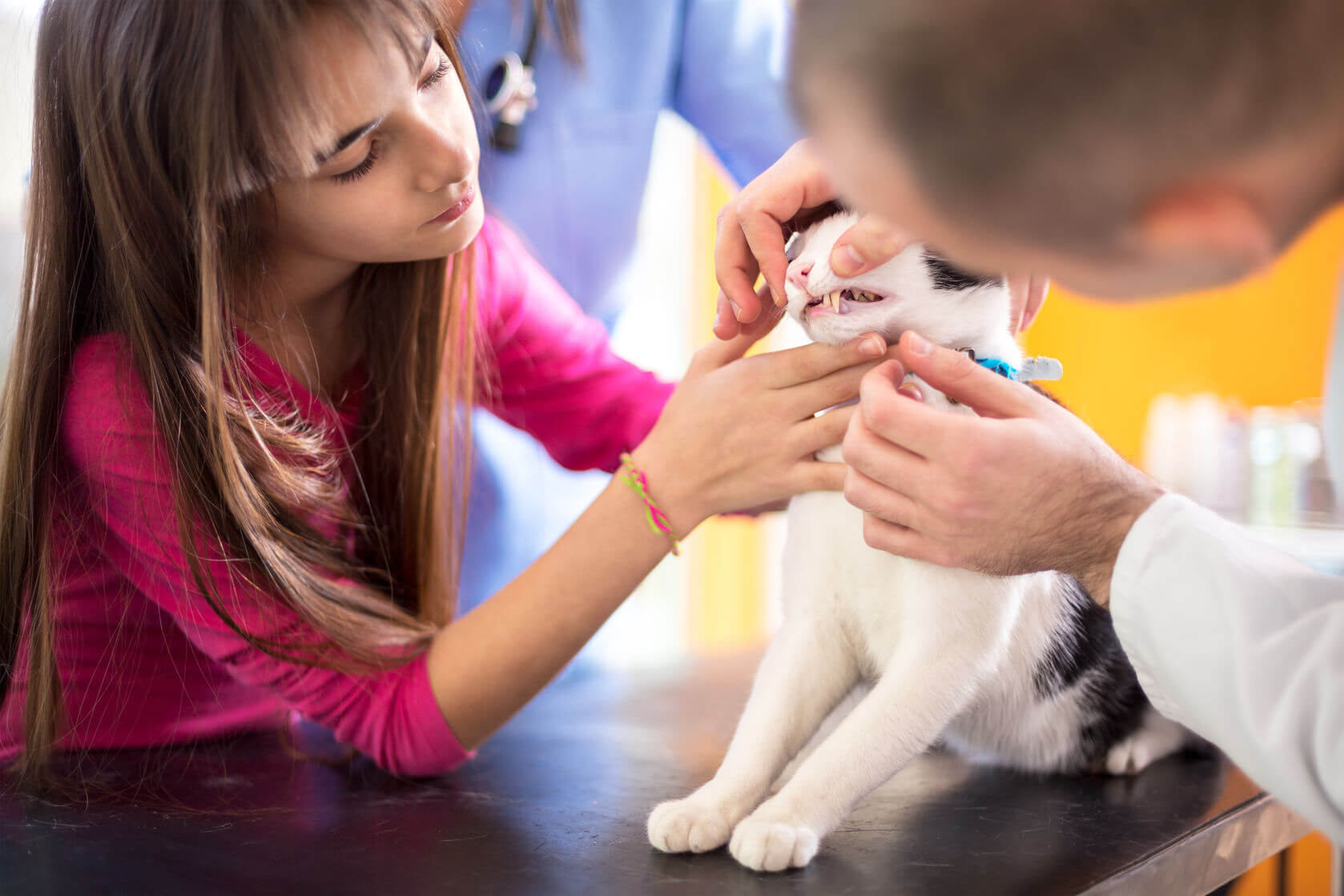
What Can you Expect from a Dental Cleaning/Exam?
We recommend for your pet to have a dental cleaning/checkup at least once a year but, do you know what to expect when you bring them in for a cleaning? What additional measurements are taken during the dental process?
When your pet comes in for their dental cleaning/exam, be prepared for him/her to be put under a general anesthesia and incubation. While they are under anesthesia we will be able to perform a thorough job.
In addition, your pet may also undergo the following procedures:
- Pre-anesthetic Exam: This examination will include blood tests, urine tests, electrocardiography, and X-Rays. The point of the exam is to ensure your pet is healthy enough to go under general anesthesia.
- Anesthesia Monitoring: While he/she is under anesthesia, his/her vital signs, i.e. body temperature, heart rate, and respiration will be monitored and recorded. This helps ensure that they are safe while under anesthesia.
- Dental Radiographs: It is important to get regular X-rays done to have your pet’s oral health checked. X-rays also help us detect any abnormalities that can not be seen through a physical exam. An X-ray can also confirm if there is a need for any extractions when teeth are loose or badly infected.
- Scaling and Polishing: Similar to our own dental cleaning, we will remove plaque and calculus from your pet’s teeth. In addition, polishing with a special paste smooths out scratches to the tooth enamel.
- Fluoride/sealants: Anti-plaque substance like fluoride treatment and/or a barrier sealant, will help strengthen and desensitize teeth and discourage the development of future plaque.
Taking care of your pet’s dental health will help him/her live a longer, healthier life.

Do you Know What Periodontal Disease is?
Did you know that poor dental hygiene can result in periodontal disease? Periodontal disease is an infection of the tissue surrounding the teeth that goes through progressive stages.
Periodontal disease begins with plaque. When bacteria attaches to the teeth and dies, it becomes rigid by the calcium in saliva. Tartar is a hard, rough substance that is then formed which allows more plaque to accumulate.
Plaque is a huge issue that can lead to gingivitis, and inflammation of the gums. The gums will become red and swollen and be prone to bleeding. Professional cleaning is needed as plaque and calculus develop below the gum line. If the buildup continues to go unchecked, infection can form around the root of the tooth.
The tissues surrounding the tooth can become destroyed in the final stages of periodontal disease. In this final stage, the bony socket holding the tooth erode, and the tooth becomes loose. This can be a very painful process for your pet.
The good news is that these problems can be averted with proper dental care.

Top 5 Reasons to Get your Pet’s Teeth Checked
There are many reasons behind why your pet’s dental health is important. Here are the top 5 reasons why their dental health should be checked on a yearly basis.
- Your pet is at risk for developing a disease or condition that is related to their dental health. i.e. periodontal disease or heart conditions.
- Gum irritation and tartar buildup can happen when baby teeth won’t come out.
- Your pet needs regular dental care just like you do.
- Dogs and cats are very good at hiding pain. You may never know when they have a serious dental health problem. Routine checkups are the only way to tell if there is a health issues.
- Teeth wear out. Your pet’s teeth may be tough but they do wear out. It’s important to keep regular dental hygiene up so that he/she can continue having healthy gums and teeth.
Taking care of you pet’s dental health will ensure a happy, healthy life.



